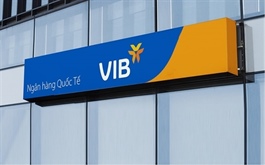Digital financial services on upward trend in Vietnam
Digital financial services on upward trend in Vietnam
Vietnam continues to see an upward trend in digital financial service adoption as digital payments gain traction.

Vietnam's digital economy is estimated to reach $30 billion in 2023 in gross merchandise value, up 19 per cent from $20 billion in 2022.
The digital economy is also on track to reach approximately $45 billion by 2025, fuelled by strong expectations of economic growth, according to the e-Conomy SEA report released at the start of November by Google, Temasek and Bain & Company.
One of the main drivers of digital economy growth is the rapid adoption of digital financial services among consumers. It is clear that the irreversible offline-to-online behaviour shift continues to fuel growth in digital financial services adoption.
The report highlights a steep growth in Vietnam's digital financial services on top of a low base. Digital payments are estimated to reach of $126 billion in 2023 in gross transaction value (GTV), up 19 per cent from $105 billion in 2022. By 2030, digital payments in Vietnam is predicted to reach $190 billion in GTV.
Cashless payments continue to flourish in Vietnam for reasons. In particular, digital payment continues to grow in the country, driven by strong support from the government, investment from commercial banks, and the widespread popularity of QR codes. This trend is expected to accelerate as the state bank promotes cashless payment services in rural and remote areas
Digital lending is another driver for digital economy growth due to high lending rates and consumer demand, as underbanked consumers and small businesses participate in the digital economy. The Vietnamese government also pushes for digital innovation in the lending space, such as Vietnam’s fintech sandboxes.
According to the report, Vietnam saw a significant rise of 31 per cent in digital lending, from $3 billion in 2022 to $4 billion in 2023. The figure is expected to double to $10 billion by 2025. Meanwhile, the digital wealth market will grow from $100 million in 2023 to about $300 million in 2025.
The usage of digital financial service apps maintains its growth trajectory. For instance, Cake by VPBank is the first digital bank to reach 4 million customers and handle VND81 trillion ($3.29 billion) in transactions. Among its 4 million existing consumers, the 25-40 age bracket accounts for the majority of Cake's market share and sales.
As of October 2023, the digital bank has mobilised VND5 trillion ($203.5 million) in online savings deposits, significantly higher than the figure of VND2 trillion ($81.4 million) at the beginning of the year. Cake is the first bank among Vietnamese digital banks to achieve this level of deposit mobilisation.
Thanks to figures like these, Cake by VPBank was named Best Digital Bank Vietnam 2023 at the Global Banking and Finance Review Awards earlier in the year.
Cake CEO Nguyen Huu Quang said, "Cake hopes to bring a financial freedom experience, help free customers from traditional models of personal finance, and take control of their lives independently. Cake's ambition is to eliminate all barriers, so everyone can enjoy comprehensive digital financial services in the most comfortable and secure way."
According to the report, the Southeast Asian region’s digital economy is set to hit $100 billion in revenue – an eight-time revenue increase for digital businesses in the last eight years. In fact, revenue is growing 1.7 times as fast as gross merchandise value, which is set to reach $218 billion this year.
Consumers are adopting digital financial services at a rapid pace in the region. Cash is no longer king, as digital payments now make up more than half of the region’s transactions. Meanwhile, digital lending is the biggest driver of the $30 billion digital financial service revenue in Southeast Asia.

























